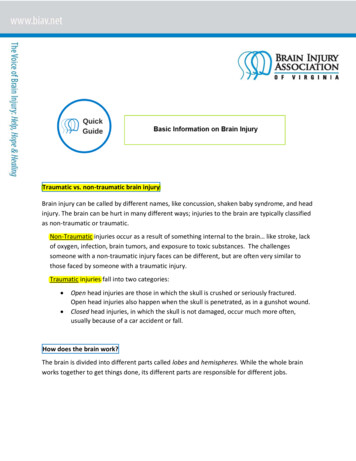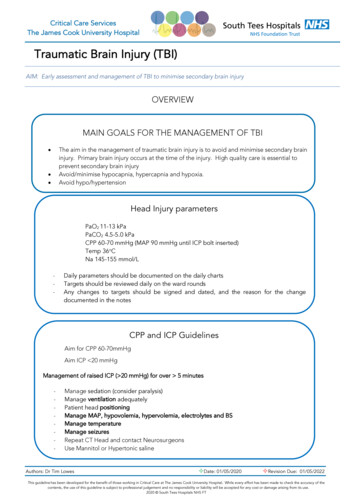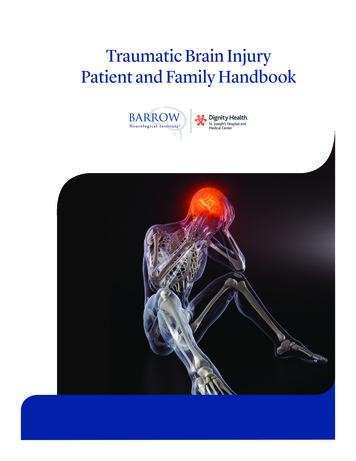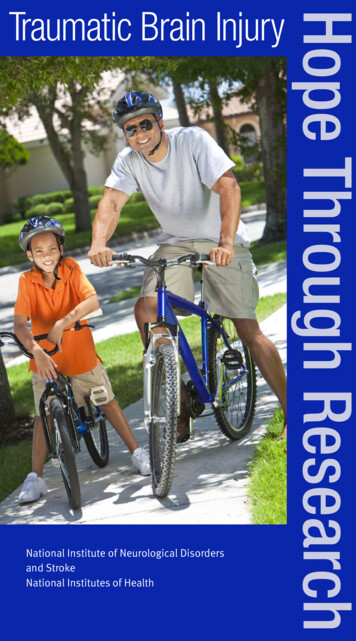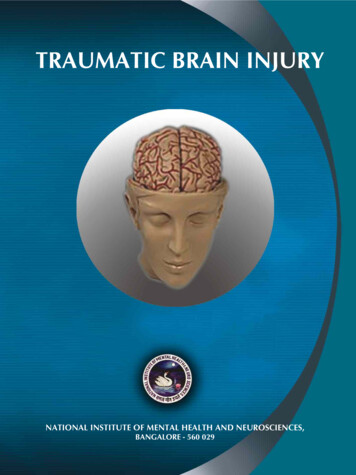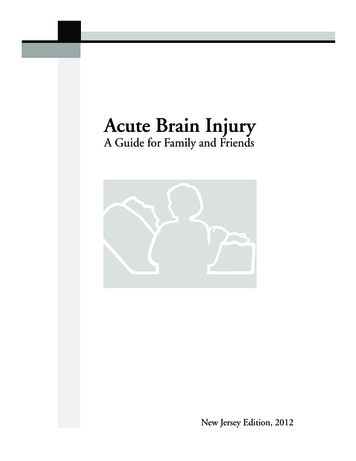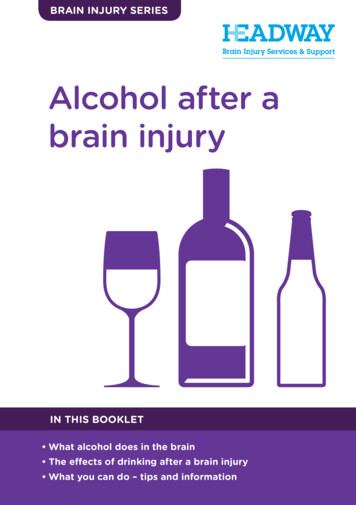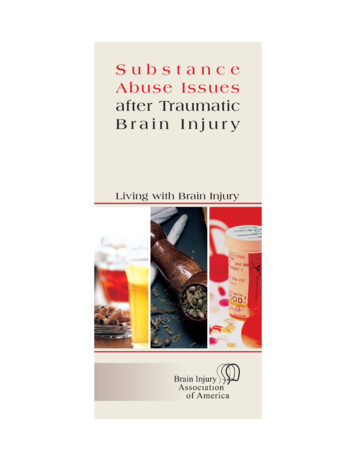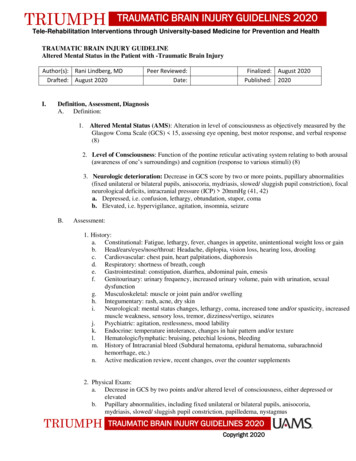
Transcription
TRIUMPHTRAUMATIC BRAIN INJURY GUIDELINES 2020Tele-Rehabilitation Interventions through University-based Medicine for Prevention and HealthTRAUMATIC BRAIN INJURY GUIDELINEAltered Mental Status in the Patient with -Traumatic Brain InjuryAuthor(s): Rani Lindberg, MDDrafted: August 2020I.Peer Reviewed:Date:Finalized: August 2020Published: 2020Definition, Assessment, DiagnosisA. Definition:1. Altered Mental Status (AMS): Alteration in level of consciousness as objectively measured by theGlasgow Coma Scale (GCS) 15, assessing eye opening, best motor response, and verbal response(8)2. Level of Consciousness: Function of the pontine reticular activating system relating to both arousal(awareness of one’s surroundings) and cognition (response to various stimuli) (8)3. Neurologic deterioration: Decrease in GCS score by two or more points, pupillary abnormalities(fixed unilateral or bilateral pupils, anisocoria, mydriasis, slowed/ sluggish pupil constriction), focalneurological deficits, intracranial pressure (ICP) 20mmHg (41, 42)a. Depressed, i.e. confusion, lethargy, obtundation, stupor, comab. Elevated, i.e. hypervigilance, agitation, insomnia, seizureB.Assessment:1. History:a. Constitutional: Fatigue, lethargy, fever, changes in appetite, unintentional weight loss or gainb. Head/ears/eyes/nose/throat: Headache, diplopia, vision loss, hearing loss, droolingc. Cardiovascular: chest pain, heart palpitations, diaphoresisd. Respiratory: shortness of breath, coughe. Gastrointestinal: constipation, diarrhea, abdominal pain, emesisf. Genitourinary: urinary frequency, increased urinary volume, pain with urination, sexualdysfunctiong. Musculoskeletal: muscle or joint pain and/or swellingh. Integumentary: rash, acne, dry skini. Neurological: mental status changes, lethargy, coma, increased tone and/or spasticity, increasedmuscle weakness, sensory loss, tremor, dizziness/vertigo, seizuresj. Psychiatric: agitation, restlessness, mood labilityk. Endocrine: temperature intolerance, changes in hair pattern and/or texturel. Hematologic/lymphatic: bruising, petechial lesions, bleedingm. History of Intracranial bleed (Subdural hematoma, epidural hematoma, subarachnoidhemorrhage, etc.)n. Active medication review, recent changes, over the counter supplements2. Physical Exam:a. Decrease in GCS by two points and/or altered level of consciousness, either depressed orelevatedb. Pupillary abnormalities, including fixed unilateral or bilateral pupils, anisocoria,mydriasis, slowed/ sluggish pupil constriction, papilledema, nystagmusTRIUMPHTRAUMATIC BRAIN INJURY GUIDELINES 2020Copyright 2020
TRIUMPHTRAUMATIC BRAIN INJURY GUIDELINES 2020Tele-Rehabilitation Interventions through University-based Medicine for Prevention and Healthc.d.e.f.g.h.i.j.k.l.m.n.o.p.q.r.s.Focal neurologic signs, including cranial nerve, motor, sensory, or speech deficitsFlexion or extension posturingBradycardia and hypotensionHyperthermia (core temperature 38.3 C) or hypothermia ( 36 C)HypoxiaAbnormal respiration, increased or decreased respiratory rateSeizure(s) complete or partial (see Management of Seizures in the Patient with TraumaticBrain Injury Guideline)Altered level of consciousness, either depressed or elevatedNew or worsening ataxiaNew or worsening cognitive impairmentTachycardia, palpitationsDiaphoresisNew or increased spasticity or muscular rigidityShivering, tremorJaundiceRash with or without pruritusSkin erythema, cellulitis, pain, purulent drainage3. Laboratory test(s):a. Rapid glucose testingb. Complete blood count with differentialc. Basic metabolic paneld. Urinalysis with urine culturee. Blood culturesf. Arterial blood gas (ABG)g. Lumbar puncture with cerebrospinal fluid (CSF) analysish. Serum and urine osmolalityi. Serum and/or urine drug levels (therapeutic and recreational drugs)j. Coagulation panelk. Thyroid function panell. Liver function panelm. Neuroendocrine labs: adrenocorticotropic hormone (ACTH), cortisol, growth hormone, insulinlike growth factor, prolactin, gonadotrophins and sex-steroid concentrationsC.4. Radiologic imaging /Other:a. Chest x-ray: Pulmonary pathology manifestations including, aspiration, pulmonary edema,consolidation pneumonia, effusion, and opacificationb. CT head scan without contrast: High sensitivity for demonstrating mass effect, midline shift,evidence of increased intracranial pressure, ventricular size and configuration, bone injuries,and acute hemorrhage in parenchymal, subarachnoid, subdural, or epidural spaces (7)c. MRI of brain: High sensitivity for detecting non-hemorrhagic primary lesions, such ascontusions, infarction, diffuse axonal injury (DAI), and secondary effects of trauma such asedema (7)d. EEG: Capture of abnormal brain wave or epileptic activity.Diagnosis1. In patients with traumatic brain injury (TBI), AMS can be defined as neurological deteriorationrelative to their baseline level of consciousness2. The common causes of AMS in TBI patients occur in the following categories:TRIUMPHTRAUMATIC BRAIN INJURY GUIDELINES 2020Copyright 2020
TRIUMPHTRAUMATIC BRAIN INJURY GUIDELINES 2020Tele-Rehabilitation Interventions through University-based Medicine for Prevention and Healtha. Intracranial complications1. Recurrent or worsening intracranial bleeding (ICB)a. It is estimated that 38-68% cases of traumatic hemorrhage will worsen/progress(3).b. A retrospective analysis of 177 initially non-operative traumatic acute subduralhematomas (SDH) found 76.8% patients had spontaneous resolution, while23.2% required delayed surgery. Time-frame for operation was 6.8% 4 hours 7 days, 13.6% between 7 - 28 days, and 2.8% one month after injury (30).c. CT parameters predictive for delayed surgery in patients with epiduralhematoma (EDH) are hematoma volume 30cm, MLS 5 mm, and a clotthickness 15 mm (42).d. In SDH and EDH, time from neurological deterioration to surgery(significantly correlated with outcome) is more important than time betweeninjury and surgery (no correlation with outcome). Every hour delay in surgicalevacuation is associated with a progressively worse outcome (42).e. Of the hemorrhages, contusions are the most likely to progress (16-75%reported in literature). This typically in the first 24hours post injury but can beseen 3-4 days out (2).2. Seizures (see Management of Seizures in the Patient with Traumatic Brain InjuryGuideline)3. Post Traumatic Hydrocephalus (PTH): The dilation of the ventricular system due to animbalance between CSF production and absorption, resulting from either insufficientabsorption, blockage, or overproduction of CSF and may present with elevated ICP orwith normal pressure hydrocephalus (NPH) (48)a. Incidence in TBI reported from 11.9-86%. In severe TBI specifically it isreported as 14.2%; 25% of which were diagnosed within 2 weeks, 50% within3 weeks, and 75% within 8 weeks of rehabilitation (12, 17).b. Clinical presentation is frequently atypical, and classic clinical symptoms ofICP or NPH (ataxia, urinary incontinence, and dementia) are frequentlyobscured.c. CT findings of posttraumatic ventriculomegaly can be as high as 80%. Criteriato differentiate PTH from atrophic ventriculomegaly include periventriculartranslucency, distended anterior horns of the lateral ventricles, enlargement ofthe temporal horns, and third ventricle in the presence of normal or absentsulci. However, the diagnostic specificity of these findings may not be asreliable as previously thought (49).d. No firm criteria for diagnosis exist. Establishing a diagnosis requires acombination of clinical deterioration or failure to improve and neuroimagingevidence of hydrocephalus.4. Post Traumatic Infarct: (13)a. Incidence of acute ischemic stroke is approximately2.5% in moderate to severeTBI.TRIUMPHTRAUMATIC BRAIN INJURY GUIDELINES 2020Copyright 2020
TRIUMPHTRAUMATIC BRAIN INJURY GUIDELINES 2020Tele-Rehabilitation Interventions through University-based Medicine for Prevention and Healthb. Risk factors include high velocity trauma and cervical dissectionc. Pharmacological complications1. Benzodiazepines: Midazolam, lorazepam, diazepama. Significant respiratory depression, sedation after drug cessation, tolerance,delirium.b. Abrupt withdrawal results in tremors, insomnia, and seizures.2. Opioid narcotics: Morphine, fentanyl, etc.a. Ventilatory depression, sedation, hallucinations, behavioral effects,hypotension, seizures, accumulation, tolerance, and withdrawal.b. Prolonged infusions of opioids may hinder neurological assessment. Whenopioids are administered as a bolus, there is a risk of increasing the ICP,particularly when the mean arterial pressure (MAP) is allowed to fall (53).3. Phenytoin:a. Shown to produce significant impairment in cognitive functions acutely (1month post-injury) in patients with severe TBI (55)b. Phenytoin displays significant drug-drug interactions, has a robust side-effectprofile and requires monitoring of serum drug level as toxicity is dosedependent and frequently affects the nervous system.4. Tricyclic antidepressants (TCA): Amitriptyline and Desipraminea. TCAs may be less effective in patients with TBI than in non-brain injuredpopulations (55).b. Anticholinergic effects and toxicity result from peripheral blockade, and if theagent crosses the blood-brain barrier, central blockade of muscarinicacetylcholine receptors occurs. Severe cases termed anticholinergic syndromemay progress to coma, seizures, and respiratory depression (58).5. Serotonin Reuptake Inhibitors (SRI): Sertraline, Fluoxetine, Paroxetine, Buspironea. Serotonin toxicity occurs when there is excessive serotonergic activity in thecentral and peripheral nervous systems that cause the classical clinical triad ofAMS, autonomic instability, and neuromuscular hyperactivity. The intensity ofclinical findings reflects the degree of serotonin toxicity, termed serotoninsyndrome when severe (57).b. Incidence of 18% in the exposed population.c. Symptoms may develop rapidly within minutes of ingestion of increased dose,addition of synergistic medication, or addition of medication that alters thehepatic metabolism of SRIs.d. Sertraline may lead to a decline in both motor function and cognition and anincrease in the number of post-concussion symptoms reported by patients,including headache, irritability, severe akathisia, and insomnia (25).e. Fluoxetine’s adverse effects include dysarthria and speech blocking.f. Buspirone’s reported side effects include headache, lightheadedness,dysphoria, akathisia, agitation, irritability, angry outbursts (55), serotonintoxicity (57).6. Lithium: adverse effects may be dose dependent (present with serum lithium levels at1.0 meq/L , resolve when reduced to 0.5 meq/L) and can include increased cognitiveimpairment, irritability, agitation, neurotoxicity, increased EEG spiking (55), andserotonin toxicity (57).7. Typical antipsychotics: HaloperidolTRIUMPHTRAUMATIC BRAIN INJURY GUIDELINES 2020Copyright 2020
TRIUMPHTRAUMATIC BRAIN INJURY GUIDELINES 2020Tele-Rehabilitation Interventions through University-based Medicine for Prevention and Healtha. Haloperidol use in TBI patients may have negative effects on cognitive andfunctional performance, duration of posttraumatic amnesia, time to cognitivefunctioning, and behavioral deficits (54).b. Risk of development of neuroleptic malignant syndrome (NMS), a lifethreatening complication of unclear pathophysiology characterized by musclerigidity, fever, autonomic instability, and fluctuating levels of consciousness(58)1. Rare complication with wide range of reported incidence rates of 0.2%to 12.2%.2. High fatality rate estimated at 15 – 18.8%.3. May progress to seizures and rhabdomyolysis, resulting in acute renalfailure and multiple systemic complications, such as pneumonia,sepsis, pulmonary embolism, pulmonary edema, and cardiac arrest.8. Atypical antipsychotics: (54) risperidone, clozapine, olanzapine, quetiapineb. Clozapine is associated with high adverse effect profile, including significantsedation, drooling, and seizuresc. Also implicated in the development of NMS.d. Infectious complications: Research suggests that catecholamines released as a result of braininjury-induced sympathetic activation to protect the brain from further inflammatory damagealso modulate cells of the immune system and induce systemic immunosuppression, increasingsusceptibility to infection (24).1. The most common infectious source in TBI is urinary tract infection (UTI) withincidence of 20%, followed by pneumonia 11%, septic shock 2%, and intracranialinfections 1% (14).2. It is estimated that 23-60% of TBI patients will develop a ventilator associatedpneumonia (24, 59).3. TBI intracranial infection incidence is 12% in non-penetrating brain injury (54).e. Metabolic or Endocrine related complications1. Neuroendocrine / Post-Traumatic Hypopituitarism (PTHP)a. Prevalence of hypopituitarism with severe, moderate, and mild TBI (as definedby post resuscitation GCS) has been reported as 35.3%, 10.9% , and 16.8%respectively (36).b. Prevalence of hypopituitarism in the chronic phase after TBI is 27.5% (36).c. Risk factors for PTHP include raised intra-cranial pressure, long admission tothe intensive care unit (ICU), diffuse axonal injury on brain imaging, and baseof skull fracture (37).d. The diagnosis of hypopituitarism is often missed or delayed due to subtlepresentation of signs and symptoms that have considerable cross-over with thesequelae of TBI i.e. fatigue, memory impairment, emotional lability, behavioraldisturbance, cognitive impairment, poor motivation, and lethargy (34, 37).2. Adrenal Insufficiency (AI): Damage to the anterior pituitary gland results in ACTHdeficiency, causing secondary adrenal failureTRIUMPHTRAUMATIC BRAIN INJURY GUIDELINES 2020Copyright 2020
TRIUMPHTRAUMATIC BRAIN INJURY GUIDELINES 2020Tele-Rehabilitation Interventions through University-based Medicine for Prevention and Healtha. Consequences of acute glucocorticoid deficiency after TBI are potentially fatal,resulting in life-threatening hyponatremia and hypotension requiringvasopressor support (38).b. Incidence of ACTH deficiency within the first 2 weeks after TBI is between4% and 78% (38).3. Central Diabetes Insipidus (CDI): decreased secretion of anti-diuretic hormone(ADH) from the posterior pituitarya. Diabetes insipidus is well recognized in the acute phase after TBI and isassociated with more severe head injury, cerebral edema, and higher mortality(37).b. Incidence in moderate to severe TBI is up to 21.6% after acute injury (36).c. 78.4% of acute phase CDI is transient has a median onset of 6 days (range 1–9days) and median duration of 4 days (37).d. The hallmark of diabetes insipidus is urine volume 3 L/day ( 40-50 ml/kgevery 24 h), and urine osmolality less than 300 mOsm/kg (22).II.4. Syndrome of Inappropriate Antidiuretic Hormone (SIADH) and Cerebral SaltWasting (CSW)a. SIADH and CSW are the two most common causes of hyponatremia inneurosurgery patients (21).b. Hyponatremia and inappropriate correction of hyponatremia is associated witha high rate of morbidity and mortality, including severe cerebral edema, mentalstatus changes, seizures, vasospasm, osmotic demyelinating syndrome, anddeath (21).c. Median onset is 3days (1-9 days). It is almost always transient and is unrelatedto the severity of the head injury (38, 39).d. Obtaining levels of hormones, such as ADH and natriuretic peptides, is notsupported by the literature (21).5. Growth hormone (GH), thyroid, and gonadal axis (37)a. No evidence that replacement of growth hormone, sex steroids, or thyroidhormone in the acute period is of benefit.b. All survivors of moderate to severe TBI should undergo screening assessmentbetween 3 and 6 months post injury of the adrenal, thyroid and gonadal axesusing the short synacthen test, baseline thyroid function tests, andgonadotrophins and sex-steroid concentrations respectively.c. Assessment of GH reserve at 1 year post injury using the insulin tolerance testor the glucagon stimulation test.Management and Treatment Recommendations1. Intracranial Complications:a. Prompt recognition of neurological deterioration and appropriate clinical assessment is essential.b. CT head scan without contrast remains the imaging modality of choice in acute neurologic deterioration(41, 46).c. MRI is recommended for patients with acute traumatic brain injury when the neurological findings areunexplained by computed tomography and is the modality of choice for the evaluation of subacute orchronic TBI (46).TRIUMPHTRAUMATIC BRAIN INJURY GUIDELINES 2020Copyright 2020
TRIUMPHTRAUMATIC BRAIN INJURY GUIDELINES 2020Tele-Rehabilitation Interventions through University-based Medicine for Prevention and Healthd. Other causes of AMS in TBI should be excluded without the delay of urgent neurosurgical evaluation1. Initial management of acute neurologic deterioration (49)a. Maintain hemodynamic stability with goal of systolic BP 90-mmHg using isotonicfluid resuscitation.b. Continuous pulse oximetry monitoring to maintain O2 saturation 90% or PaO2 60mm Hg on ABG using supplemental oxygen1. Hypoxemia not corrected with supplemental O2, GCS 9 or inability tomaintain the airway warrants bag mask ventilation or rapid sequenceendotracheal intubationa. Hypotension and hypoxemia are statistically independent predictors ofoutcome.c. Brief periods of hyperventilation therapy of 20 breaths per minute (PaCO2 35mmHg) should be used as a temporizing measure when clinical signs of cerebralherniation are evident by progressive neurologic deterioration, and discontinued whenthe clinical signs resolve.d. Immediate transport for CT scanning and neurosurgical evaluation.e. Patients with signs of progressive neurological deterioration referable to theintracranial lesion, medically refractory intracranial hypertension, or signs of masseffect on CT scan should be evaluated by a Neurosurgeon.f. PTH: Symptomatic hydrocephalus is indication for diversion of CSF via surgicalplacement of a ventriculoperitoneal shunt (17, 47).2. Pharmacological complicationsa. Management and treatment include discontinuation of the offending medication and supportivetreatment of symptoms.b. Benzodiazepines are not recommended as sleep aids in patients with TBIc. Serotonin toxicity (57,58)1. First-line management involves withdrawal of the offending serotonergic drugs andsupportive care with external cooling and hydration.a. With sufficient treatment, mild toxicity symptoms should resolve within 24 to72 hoursb. Antipyretics are ineffective as hyperthermia is secondary to muscle rigidityrather than hypothalamic temperature set point2. Hospitalization is required in moderate to severe cases involving hypertonicity,hyperthermia, autonomic instability, or progressive cognitive changes.3. Benzodiazepines may be used for control of muscle rigidity, agitation and tremor.4. Severe hyperthermia and muscle rigidity warrant neuromuscular paralysis, sedation,and possible intubation to prevent or halt progression to rhabdomyolysis.5. Use of the serotonin 2A antagonist Cyproheptadine as an antidote is recommended withinitial dose of 12 mg orally, followed by 2 mg every two hours until symptoms cease,and followed by maintenance dosage of 8 mg every six, hours not to exceed 0.5mg/kg/day.6. An alternative, less sedating antidote is chlorpromazine hydrochloride, which is givenintramuscularly at doses of 50–100 mg and repeated as necessary every 6 hours (68).7. Use of propranolol, bromocriptine, and dantrolene are not recommended as they mayresult in hypotensive shock, exacerbation of symptoms, or have no effect on survivalrespectively (58).d. Antipsychotics/Atypical Antipsychotics/NMS: (58)1. Immediate discontinuation of dopamine-blocking agents.2. Immediate initiation of supportive measures to include volume resuscitation andexternal cooling.TRIUMPHTRAUMATIC BRAIN INJURY GUIDELINES 2020Copyright 2020
TRIUMPHTRAUMATIC BRAIN INJURY GUIDELINES 2020Tele-Rehabilitation Interventions through University-based Medicine for Prevention and Health3. Benzodiazepines such as lorazepam and midazolam should be administered at dosesstarting at 1–2 mg intramuscularly or intravenously every four to six hours.4. Centrally acting dopamine agonists, such as bromocriptine, levodopa, and amantadine,have been utilized successfully and are recommended in cases that fail to improve withsupportive care; however, data on validity is limited.5. In severe cases, dantrolene sodium can be used as monotherapy or in conjunction withdopamine agonists to relax skeletal muscle without causing total paralysis. It is giveninitially as a bolus 1.0–2.5 mg/kg and continued until signs of hypermetabolism subsideor until a cumulative dose of 10 mg/kg is administered.6. Dantrolene is continued at a dosage of 1 mg/kg every 4–6 hours for at least 24 hours toprevent the recurrence of symptoms.7. When feasible, dantrolene is changed to oral route at a dosage of 4–8 mg/kg/daydivided into four doses and continued for 1–3 days to prevent the recurrence ofsymptoms.8. Common adverse effects of intravenous or intramuscular dantrolene administration aremuscle weakness, phlebitis, and most seriously hepatic toxicity.9. Symptoms typically resolve within 6–10 days after treatment is initiated.3. Infectious complications:a. Diagnosis is made in light of presenting clinical features, positive culture of the infecting organismwhere contamination is excluded, and /or radiological evidence of infection.b. Antimicrobial Therapy1. Initial empiric anti-infective therapy is indicated in patients with sepsis to include one or moredrugs that have activity against all likely pathogens (bacterial and/or fungal or viral) and thatpenetrate in adequate concentrations into tissues presumed to be the source of infection.2. Antimicrobial regimen should be reassessed daily for potential de-escalation to the mostappropriate single therapy as soon as the susceptibility profile is known.3. Empiric combination therapy should not be administered for more than 3–5 days.4. Use of low procalcitonin levels or similar biomarkers can assist the clinician in thediscontinuation of empiric antibiotics in patients who initially appeared septic, but who have nosubsequent evidence of infection.5. Combination empirical therapy is used for neutropenic patients with severe sepsis and patientswith multidrug resistant bacterial pathogens.6. Duration of therapy is typically 7–10 days; longer courses may be appropriate in patients whohave a slow clinical response, undrainable foci of infection, bacteremia with S. aureus; or somefungal and viral infections or immunologic deficiencies, including neutropenia.7. Antiviral therapy should be initiated as early as possible in patients with severe sepsis or septicshock of viral origin.8. Antimicrobial agents should not be used in patients with severe inflammatory statesdetermined to be of noninfectious cause.c. Source Control1. A specific anatomical diagnosis of infection requiring consideration for emergent sourcecontrol must be sought and diagnosed or excluded as rapidly as possible, and intervention mustbe undertaken for source control within the first 12 hr. after the diagnosis is made.2. When source control in a severely septic patient is required, the effective interventionassociated with the least physiologic insult should be used (e.g., percutaneous rather thansurgical drainage of an abscess).3. If intravascular access devices are a possible source of sepsis, they should be removedpromptly after other vascular access has been established.d. Infection PreventionTRIUMPHTRAUMATIC BRAIN INJURY GUIDELINES 2020Copyright 2020
TRIUMPHTRAUMATIC BRAIN INJURY GUIDELINES 2020Tele-Rehabilitation Interventions through University-based Medicine for Prevention and Health1. Oral chlorhexidine gluconate can be used as a form of oropharyngeal decontamination toreduce the risk of ventilator-associated pneumonia in ICU patients with severe sepsis.2. Peri-procedural antibiotics for intubation should be administered to reduce the incidence ofpneumonia (41).3. In acute TBI, early tracheostomy should be performed to reduce mechanical ventilation days(41).4. Ventriculostomies and other ICP monitors should be placed under sterile conditions to closeddrainage systems, minimizing manipulation and flushing. Routine ventricular catheter exchangeor prophylactic antibiotic use for ventricular catheter placement is not recommended to reduceCSF infections (41).5. There is no support for the use of antibiotics for systemic prophylaxis longer than 48 hours inintubated TBI patients given the risk of selecting for resistant organisms (41).4. Endocrine and metabolic complicationsa. Adrenal insufficiency (AI)1. Closely monitor signs and symptoms of hypocortisolism, including hyponatremia, hypotensionresistant to inotropes, hypoglycemia, or unexpected slow recovery (36).2. During the acute phase (Days 1-7) of moderate to severe brain injury, it warrants dailymonitoring of morning serum cortisol levels. Measurement of less than 7.2 μg/dL (200 nmol/L)are suggestive of adrenal insufficiency and stress dose glucocorticoid replacement should beinstituted. Values between 7.2 and 18 μg/dL (200-500 nmol/L) in the presence of AI featuresmay still be inappropriately low, and a trial of glucocortioid therapy should be considered (36).3. During the chronic phase ( 2 weeks): The insulin tolerance test is considered the criterionstandard for assessing the growth hormone and the adrenal axes. It is contraindicated in acuteTBI and in patients with severe cardiovascular disease and uncontrolled epileptic seizures. Insuch cases, the use of the glucagon test confirmed with the short synacthen test is utilized (36).4. Persistent/chronic hypocortisolemia warrants hormone replacement treatment with standard oralmaintenance dose (36,38).b. Central diabetes insipidus1. Acute phase CDI: hypotonic polyuria associated with presence of hypernatremia and /orelevated plasma osmolality warrants trial of injection subcutaneously or intravenously of 1 µg of1-deamino-8-D-arginine vasopressin (DDAVP). A greater than 50% increase in urine osmolalitymeasurement in 1-2hours confirms the diagnosis (22).2. Chronic phase CDI is formally evaluated using a standard 8-hour water deprivation test,followed by desmopressin challenge (38).3. Acute phase CDI warrants immediate hormone replacement therapy with desmopressin(subcutaneously or intramuscularly) and hypotonic fluids guided by the urine output and theplasma sodium (37).4. Chronic phase CDI is maintained with oral desmopressin (38).III.c. SIADH/CSW1. Acute symptomatic hyponatremia ( 48 hours): Correction with hypertonic saline (3 %) to raiseplasma sodium by 1–2 mmol/h to a total of 4–6 mmol to alleviate signs and symptoms,followed by chronic correction guidelines (40).2. Chronic ( 48 hours) hyponatremia: Correction should be no faster than 0.5 mmol/h to avoidthe risk of osmotic demyelination syndrome (40).Prevention and EducationA. Education of the caregiver and patient on common complications after traumatic brain injury is essential inearly detection of intracranial, pharmacological, infectious, metabolic , and endocrine -relatedcomplications that may result in altered mental status.TRIUMPHTRAUMATIC BRAIN INJURY GUIDELINES 2020Copyright 2020
TRIUMPHTRAUMATIC BRAIN INJURY GUIDELINES 2020Tele-Rehabilitation Interventions through University-based Medicine for Prevention and HealthB.C.Use the smallest effective dose of medications for management of pain, spasticity, mood/behavioral issues,and seizures.Routine follow up with a medical team familiar with metabolic and endocrine issues that may occur afterTBI is important for monitoring and early detection of complications.This guideline was developed to improve health care access in Arkansas and to aid health care providers in makingdecisions about appropriate patient care. The needs of the individual patient, resources available, and limitationsunique to the institution or type of practice may warrant variations.Guideline DevelopersDeveloped by Dr. Rani Lindberg, M.D. in collaboration with the TRIUMPH Team led by Medical Directors Dr.Thomas S. Kiser, M.D. and Dr. Rani Haley Lindberg, M.D.References:1. Husson EC et.al. Prognosis of six-month functioning after moderate to severe traumatic brain injury: asystematic review of prospective cohort studies. J Rehabil Med. 2010 May;42(5):425-36. doi:10.2340/16501977-05662. Adatia, Krishma et al. “Contusion Progression Following Traumatic Brain Injury: A Review ofClinical and Radiological Predictors, and Influence on Outcome.” Neurocritical care, 1–13. 27 May.2020, doi:10.1007/s12028-020-00994-43. Cepeda, S., Castaño-León, A., Munarriz, P. M., Paredes, I., Panero, I., Eiriz, C., Gómez, P. A., &Lagares, A. (2019). Effect of decompressive craniectomy in the postoperative expansion of traumaticintracerebral hemorrhage: a propensity score–based analysis, Journal of Neurosurgery JNS, 132(5),1623-1635.4. Joseph B. Prospective validation of the brain injury guidelines: Managing traumatic brain injurywithout neurosurgical consultation. J Trauma Acute Care Surg. 2014 Dec;77(6):984-8. doi:10.1097/TA.0000000000000428.5. Nakase-Richardson R. Arch Phys Med Rehabil. 2013 Oct;94(10):1884-90. doi:10.1016/j.apmr.2012.11.054. Epub 2013 Jun 14. Do rehospitalization rates differ among injuryseverity levels in the NIDRR Traumatic Brain Injury Model Systems program?6. Smith JS. The role of early follow-up computed tomography imaging in the management of traumaticbrain injury patients with intracranial hemorrhage. J Trauma. 2007 Jul;63(1):75-82.7. Davis, Patricia C. et.al. American College of Radiology ACR Appropriateness Criteria: Head ve/.Review 2012. Accessed 12/22/20148. Randall L Braddom; Leighton Chan; Mark A Harrast; et al. Physical medicine and rehabilitation 4thedition. Philadelphia, PA : Saunders/Elsevier, 2011.9. Ge
contusions, infarction, diffuse axonal injury (DAI), and secondary effects of trauma such as edema (7) d. EEG: Capture of abnormal brain wave or epileptic activity. C. Diagnosis 1. In patients with traumatic brain injury (TBI), AMS can be defined as neurological deterioration relative to their baseline level of consciousness 2.

